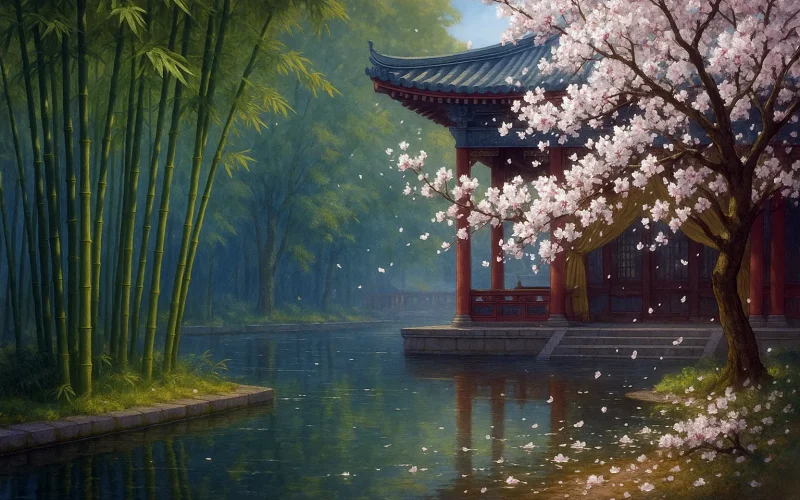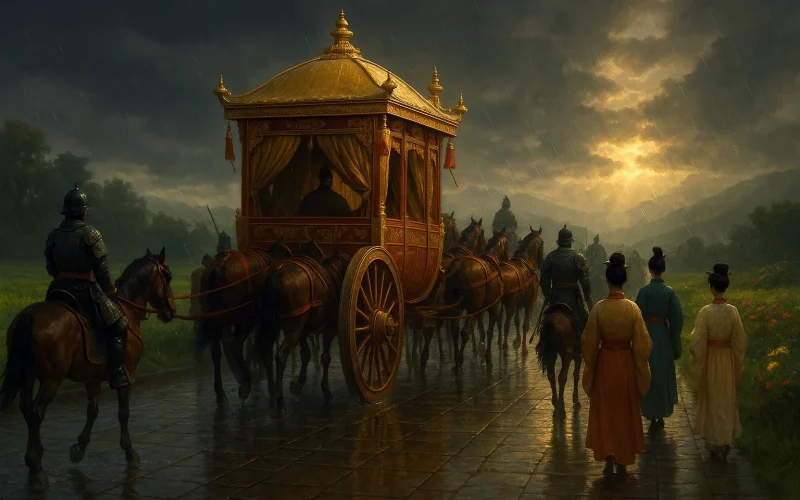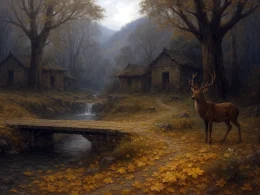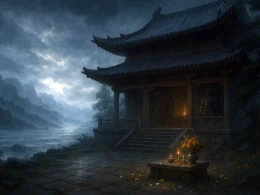The hall of songs overlooks the lucid streams;
The pavilion of dances joins lakes bright.
The bamboo’s green ‘neath frost remains;
The mume bloom’s sweet before snow appears.
The widgeons come to call their mates;
The wild geese rise to fly in rows.
They clean their feathers on the lake,
For royal favor we’re fed.
Original Poem
「侍宴归雁堂」
虞世南
歌堂面渌水,舞馆接金塘。
竹开霜后翠,梅动雪前香。
凫归初命侣,雁起欲分行。
刷羽同栖集,怀恩愧稻粱。
Interpretation
This poem is a work composed by Yu Shinan for an imperial occasion. "Returning Geese Hall" was a banquet venue in the Tang palace, where the imagery of wild geese often symbolized thoughts of homecoming and a subject's gratitude for imperial virtue. Written for a court banquet, the poet depicts the hall's scenery and natural elements, blending courtly splendor with natural freshness to express a subject's gratitude for imperial favor and praise for a harmonious, beautiful life.**
First Couplet: "歌堂面渌水,舞馆接金塘。"
Gē táng miàn lù shuǐ, wǔ guǎn jiē jīn táng.
The singing hall faces the clear, green waters;
The dancing pavilion adjoins the gilded pond.
This couplet describes the banquet setting. "Clear, green waters" depict the purity of the pond, suggesting clarity and elegance, while "gilded pond" highlights the luxurious beauty of the palace grounds. The couplet combines dynamic and static elements: the sounds of music and the sight of clear waters create a scene where the court and nature reflect each other, portraying both reality and the beauty of a prosperous era.
Second Couplet: "竹开霜后翠,梅动雪前香。"
Zhú kāi shuāng hòu cuì, méi dòng xuě qián xiāng.
After frost, the bamboo unfolds its emerald green;
Before snow, the plum blossoms stir with subtle fragrance.
This couplet describes the transitional scenery between seasons. Bamboo and plum blossoms traditionally symbolize integrity and purity. Here, the scenery conveys emotion: on one hand, it reflects the elegant style of the palace grounds; on the other, it alludes to the integrity and character of the literati. The bamboo appears greener after frost, and the plum blossoms emit fragrance before snow, implying that one's true nature and strength are revealed in harsh environments.
Third Couplet: "凫归初命侣,雁起欲分行。"
Fú guī chū mìng lǚ, yàn qǐ yù fēn háng.
The teal return, first calling to their mates;
The wild geese rise, preparing to form their ranks.
This couplet shifts from plants to birds, describing fowl activities in autumn and winter. The paired teal symbolize reunion and harmony; the wild geese forming ranks imply lofty aspirations and migration. One static and one dynamic, they represent the vitality of nature and the passage of time, while also expressing the poet's appreciation for family and friendship.
Fourth Couplet: "刷羽同栖集,怀恩愧稻粱。"
Shuā yǔ tóng qī jí, huái ēn kuì dào liáng.
Preening their feathers, they roost together;
Harboring gratitude, I feel unworthy of this sustenance.
This couplet reveals the theme. Even birds know to rely on each other when gathering, so how much more should a subject feel grateful for the emperor's great favor? The final line, "feel unworthy of this sustenance," expresses the poet's modesty, indicating that while he enjoys an official salary, he feels ashamed of not having served to his fullest capacity. This is a typical conclusion for occasional court poetry, steering the description of scenery toward political ethics and personal reflection.
Holistic Appreciation
The poem begins with the banquet setting, moves to natural scenery and bird activities, and concludes with emotional expression and gratitude. The first two couplets describe the environment and seasonal changes, showcasing both the court's magnificence and the elegance of nature. The following couplets focus on birds, conveying emotions through scenery, alluding to reunion, parting, and loyalty. The concluding line, "Harboring gratitude, I feel unworthy of this sustenance," clarifies the theme of the subject's gratitude. The poem fulfills the function of occasional poetry—"praising the sovereign and expressing gratitude"—while maintaining Yu Shinan's characteristically clear and elegant style.
Artistic Merits
- Integration of Court and Nature: The splendor of the palace and the freshness of nature complement each other, creating majesty without losing elegance.
- Balance of Dynamic and Static: From "clear waters" to "teal and wild geese," the scenery combines movement and stillness, with clear layers in the imagery.
- Rich Symbolism: Bamboo and plum blossoms symbolize purity, while teal and wild geese represent reunion and lofty aspirations, all echoing the ideals of the literati.
- Emotion Through Scenery: The poem is largely descriptive, but the final couplet turns to express "gratitude," achieving an emotional升华.
- Typical Occasional Style: Though depicting nature and birds, it ultimately conveys the subject's gratitude, conforming to the function of court poetry.
Insights
This work begins with the singing and dancing in the palace grounds, transitions to the scenery of bamboo and plum blossoms, and the activities of teal and wild geese, concluding with the modest sentiment of "feeling unworthy of this sustenance." The poem contains both magnificent banquets and elegant natural beauty, as well as the symbolism of birds relying on each other and geese forming ranks for long journeys. It reminds people to maintain clarity and modesty amid prosperity and excitement. The court's splendor and nature's freshness are merely external reflections; what truly matters is holding gratitude in one's heart and cherishing the favors one has received. Even in moments of glory, one should remain humble and steadfast, so as to live up to the present and remain true to oneself.
About the Poet
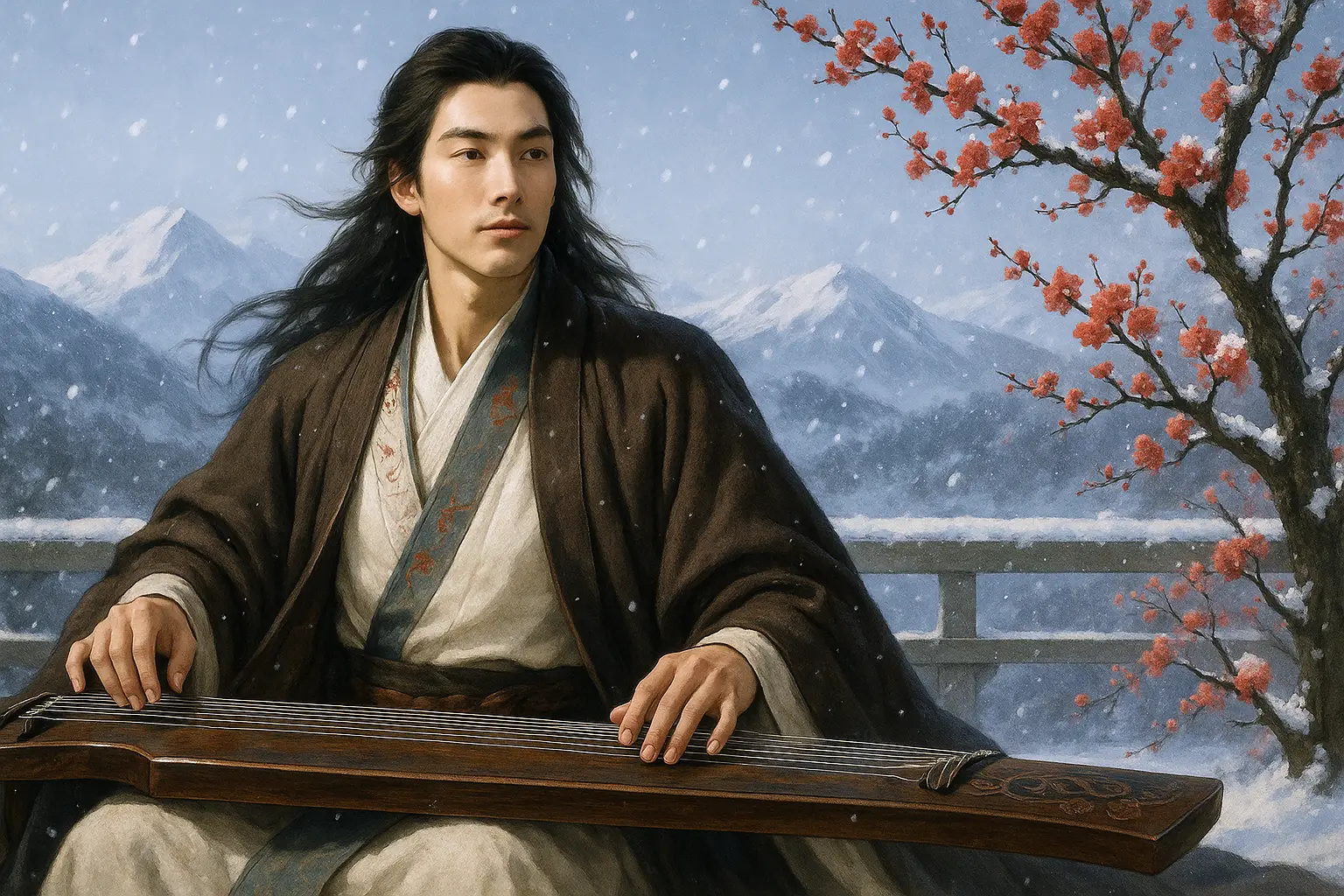
Yu Shinan (虞世南 558 - 638), a native of Yuyao in Zhejiang Province, was a prominent statesman, writer, calligrapher, and politician during the Zhenguan era of the early Tang dynasty. As one of the "Twenty-Four Meritorious Officials of Lingyan Pavilion," he rose to the position of Director of the Imperial Library. His calligraphy earned him a place among the "Four Great Calligraphers of the Early Tang," alongside Ouyang Xun, Chu Suiliang, and Xue Ji. In poetry, he inherited the tradition of Xu Ling and pioneered a refined, balanced, and harmonious courtly style. He also compiled the North Hall Book Excerpts, establishing a new genre of encyclopedic literature.






